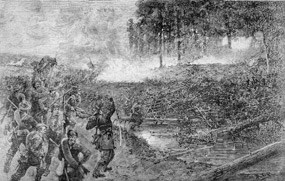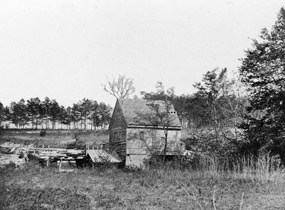
Known in the South as the Battle of Mechanicsville, or the Battle of Ellerson's Mill, the June 26 battle is recognized today for its connection with the rise of Robert E. Lee and the Confederate army in Virginia. On the morning of the 26th, portions of the Army of the Potomac lay within sight of Richmond. The Fifth Corps, under Fitz John Porter, occupied the high ground around Mechanicsville, about five miles northeast of Richmond, and overlooking the swampy valley of the Chickahominy River. The Confederate battle plan for the 26th called for a decisive maneuver by Thomas J. “Stonewall” Jackson’s command, which had arrived north of Richmond directly from the Shenandoah Valley. Lee expected Jackson’s force to effect a turning movement, getting above and behind the Union army, threatening its supply route. Jackson’s presence would produce two beneficial results for Lee’s army. It would force the Union soldiers out of Mechanicsville, and it would clear the way for Lee to move much of his army to the northern side of the river, creating a numerical advantage that would allow Lee to launch attacks. The inevitable variables associated with military operations crippled the Confederate plan. Although Jackson and his men covered 18 miles of difficult marching on June 26, they did not arrive north of Mechanicsville as early as anticipated. Confederate division commander A. P. Hill, of Lee’s own force, initiated a crossing of the Chickahominy at Meadow Bridges anyway. His unexpected move triggered the Confederate offensive and inaugurated the Seven Days battles. Hill’s men swept into Mechanicsville, driving off light resistance from the “Pennsylvania Reserves” division of George A. McCall. That division, which numbered three brigades of infantry and a strong force of artillery, included George Meade and John Reynolds, each destined for great fame and responsibility later in the Civil War. The Pennsylvanians willingly abandoned Mechanicsville in favor of a strong defensive position on the eastern side of Beaver Dam Creek, about one mile from the village. Beaver Dam Creek was, and still is, a fairly swampy body of water in a steeply shouldered valley. Earlier in June soldiers had felled trees as obstructions. In some places they built an earthen parapet to shelter both infantrymen and cannon. The position also enjoyed a wide field of fire, making any direct approach dangerous for the attackers. Beaver Dam Creek had only one significant flaw as a defensive position: it was vulnerable to being turned, or flanked, at its northern end. Once Lee and part of his army crossed the Chickahominy and reached the little crossroads burg at Mechanicsville, they wheeled to the east and tested McCall’s position at Beaver Dam Creek. Five of the six brigades under A. P. Hill—perhaps 11,000 men—pushed to the edge of the creek, receiving heavy doses of artillery fire the entire way. Lee did not harbor hopes of storming the creek and carrying the Union position. Instead, he wanted to fix McCall’s men in position while Jackson reached a favorable spot to the north, compromising the Beaver Dam Creek line. Lee also worried that the balance of the Federal army, south of the Chickahominy River, might grow aggressive and attack Richmond directly while 75% of the Confederate army stood stalled on the north side of the river. This dangerous situation involved many complicating factors: the inhospitable river, the powerful Union position at Beaver Dam Creek, the uncertain progress of Stonewall Jackson, and the setting sun. At Beaver Dam Creek, some of the Confederate generals grew more aggressive than planned. At least four brigades actually attacked the creek head-on, losing scores of men without denting the Union line. Roswell Ripley’s brigade, of D. H. Hill’s division, incurred nearly 600 casualties—all dead and wounded—which represented almost one-half of Lee’s losses for the entire battle. 
Library of Congress On the Union side, Pennsylvania infantry from Truman Seymour’s brigade manned the slopes near Ellerson’s Mill, along the creek. John Reynolds’s brigade defended the upper portion of Beaver Dam Creek. Together they blasted all approaching Confederates with deadly rifle and musket fire. As usual with Civil War battles, the arrival of darkness signaled the end of combat. No Confederate had reached the Union line on the eastern side of the creek. Lee’s army absorbed about 1400 casualties, to only 350 for the Pennsylvanians. Strangely enough, both sides could argue that they had met their objectives. By any definition, Beaver Dam Creek was a Union victory. Porter’s Fifth Corps (primarily McCall’s Pennsylvania Reserves) stood firm and won a battlefield victory. Lee had lost his first battle as commander of the Confederate army; yet his plan, despite many problems, remained viable. Jackson’s army finally reached the headwaters of Beaver Dam Creek late on June 26, forcing the Union troops away from the creek and into retreat. The main Union army in front of Richmond had not threatened the city during this vulnerable half-day, and subsequently Lee would dictate the pace as his momentum grew and the week of battles progressed. Before dawn on June 27, the Union troops abandoned their Beaver Dam Creek entrenchments and fell back to high ground beyond Gaines’s Mill. In the process, they began a retreat that would not end until July 2, some 30 miles southeast of Richmond along the banks of the James River. The northern portion of the Beaver Dam Creek battlefield has been destroyed by development, but Richmond National Battlefield Park owns and protects 365 acres along the lower section of the stream. That includes some of the ground where Ripley’s, Pender’s, and Field’s Confederate brigades suffered through their attack, and where Seymour’s Pennsylvanians stood firm. A short walking trail takes visitors across the historic creek from the Confederate side to the Union side. |
Last updated: February 26, 2015
